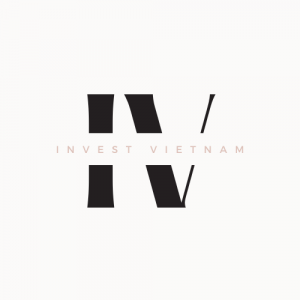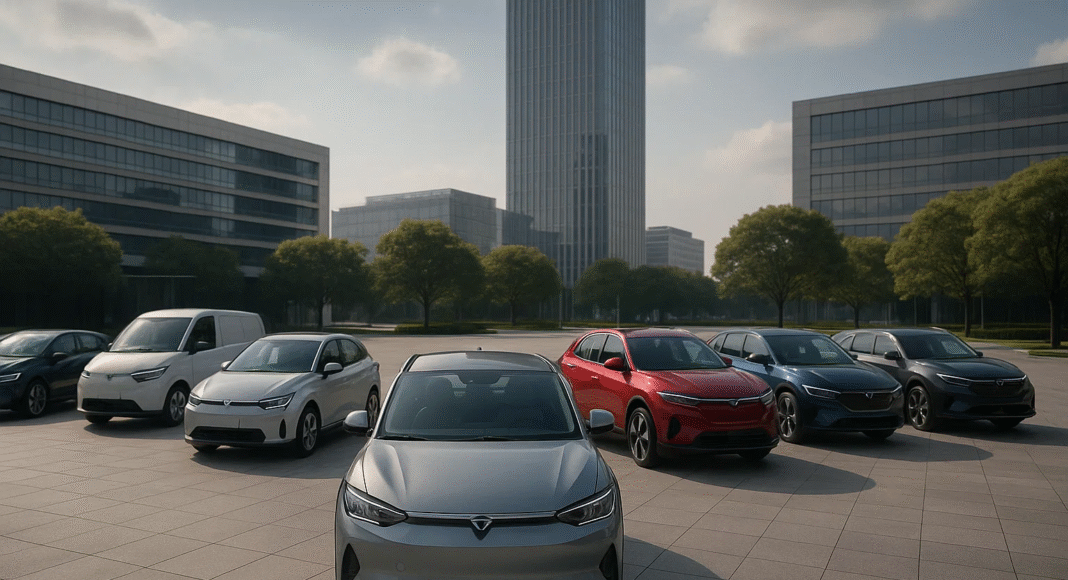Key Takeaways
- VinFast leads Vietnam’s EV market in 2025 with affordable models, extensive infrastructure, and local production.
- Global and Chinese brands like BYD, Hyundai, and MG intensify competition with diversified offerings and strategic localization.
- Government incentives, rising green awareness, and infrastructure expansion drive rapid EV adoption across Vietnam.
Vietnam’s automotive landscape is undergoing a remarkable transformation in 2025, driven by the global push for sustainable mobility, escalating fuel costs, government incentives, and a rising environmental consciousness among consumers. At the heart of this shift is the surging demand for electric vehicles (EVs), which has gained extraordinary momentum over the past few years. From compact urban electric cars to high-performance EVs and electric two-wheelers, Vietnam is fast emerging as one of Southeast Asia’s most exciting electric vehicle markets.
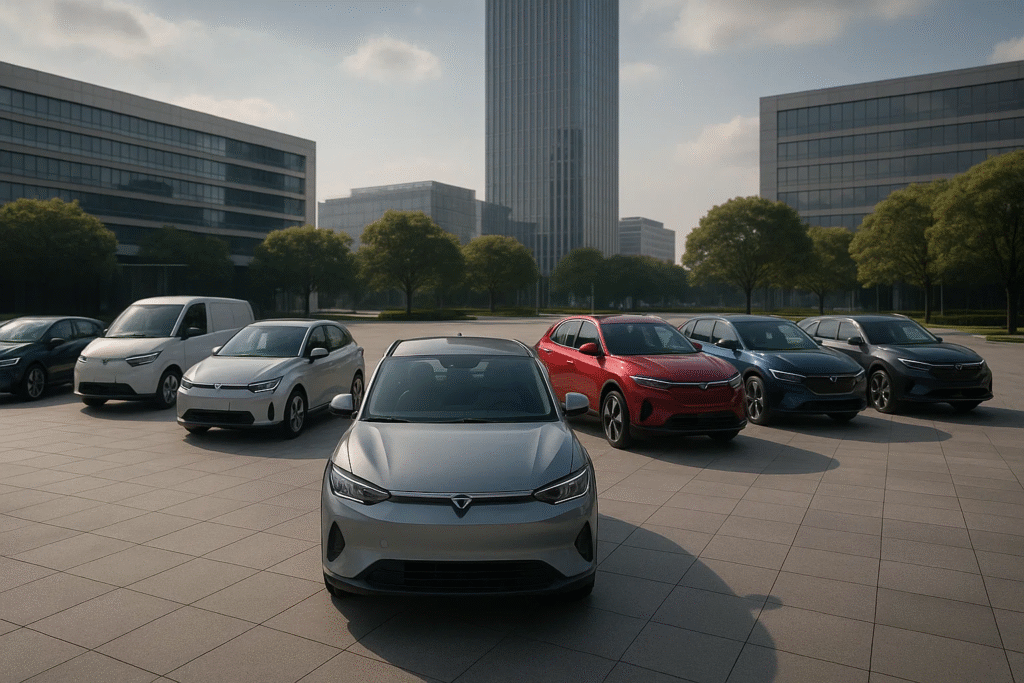
The Vietnamese government’s strong commitment to achieving net-zero carbon emissions by 2050 has catalyzed a flurry of investments in EV infrastructure and green technology. National policies such as tax exemptions, registration fee reductions, and subsidies for EV buyers have helped accelerate adoption. Additionally, major infrastructure initiatives—such as expanding the national EV charging network and integrating smart mobility platforms—are laying the groundwork for a vibrant and sustainable EV ecosystem. As a result, both global automotive giants and emerging local players are rushing to capture a share of this rapidly expanding market.
Local companies like VinFast have taken center stage, not only dominating the domestic EV market but also making bold forays into international territories. Their innovative designs, aggressive pricing, and rapid scaling capabilities have positioned them as formidable competitors to long-established brands. Meanwhile, international automakers such as Tesla, BYD, Kia, Hyundai, and MG are strategically entering or expanding their presence in Vietnam, attracted by the country’s young population, fast-growing middle class, and urbanization trends. Many of these brands are offering localized EV models tailored to Vietnamese road conditions, price sensitivities, and consumer preferences.
Furthermore, the two-wheeler segment—integral to Vietnamese daily life—has seen an electric revolution of its own. Brands like Yadea, VinFast, and Dat Bike are rapidly electrifying the traditional scooter and motorbike scene, reshaping urban commuting and reducing emissions in densely populated cities like Ho Chi Minh City and Hanoi.
As competition heats up, EV brands are not only focusing on launching new models but also on improving after-sales services, offering better warranties, integrating smart features, and building brand loyalty through digital platforms and eco-conscious marketing. The availability of financing options, leasing models, and battery-swapping technologies are also helping reduce barriers to entry for the average Vietnamese consumer.
This comprehensive blog post explores the Top 10 Electric Vehicle Brands in Vietnam in 2025, examining their market performance, product line-ups, innovation strategies, and future outlook. Whether you’re an investor seeking opportunities in Vietnam’s green mobility sector, a policymaker tracking EV trends, or a consumer interested in switching to electric, this guide offers deep insights into the brands shaping the future of transportation in Vietnam.
Stay with us as we delve into the strengths, challenges, and competitive dynamics of each brand, supported by the latest data, expert opinions, and real-world user reviews—making this the ultimate resource on Vietnam’s EV industry in 2025.
Top 10 Electric Vehicle Brands in Vietnam in 2025
1. VinFast
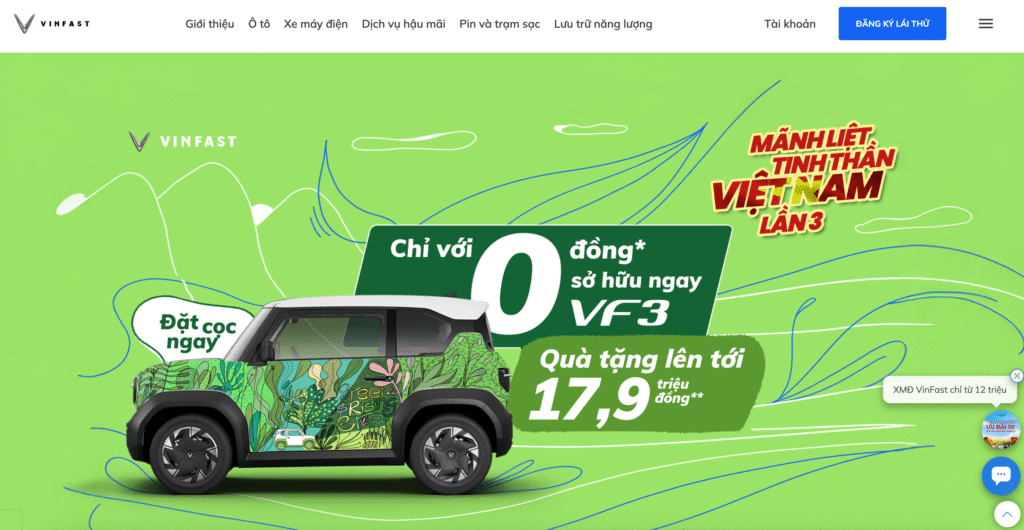
VinFast, a wholly owned subsidiary of Vietnam’s largest conglomerate Vingroup, has rapidly ascended to the forefront of the electric vehicle (EV) industry in Vietnam and Southeast Asia. Its bold market entry strategy, vertically integrated business model, and rapid innovation pipeline have enabled it to dominate the domestic landscape while simultaneously expanding its international footprint.
1. Market Leadership and Sales Dominance
VinFast has firmly established itself as Vietnam’s best-selling EV brand and a top-tier contender in the global EV arena.
1.1 Unrivaled Market Share in 2025
- VinFast’s market share surged from 9.2% in 2023 to 21.3% by end of 2024.
- As of H1 2025, it commanded nearly 30% of Vietnam’s total automobile market, not just EVs.
- It delivered 67,569 EVs in Vietnam in the first half of 2025 alone, outpacing all domestic and foreign competitors.
1.2 Rapid Sales Acceleration
| Metric | 2023 | 2024 | H1 2025 |
|---|---|---|---|
| Domestic Sales | 34,800 units | 87,000 units | 67,569 units |
| Global Deliveries Target | – | 80,000 units+ | On track |
| Revenue (Q1 YoY Growth) | – | +149.9% | $656.5 million |
| Q1 EV Deliveries Growth | – | +296% YoY | 36,330 units |
1.3 Strategic B2B Collaborations
- VinFast’s sales performance is bolstered by large-volume purchases from Xanh SM, a green taxi operator and strategic partner.
- These fleet-based transactions have created a stable and recurring demand base for VinFast’s compact and commercial EV offerings.
2. Model Portfolio and Product Innovation
VinFast’s product diversification, particularly in the budget and mini-SUV segments, has significantly contributed to its market traction.
2.1 High-Volume Flagship Models
| Model | Total Deliveries (2024) | May 2025 Sales | YTD May 2025 |
|---|---|---|---|
| VF 3 (Mini SUV) | 25,000+ | 3,950 units | 19,416 units |
| VF 5 (Compact SUV) | 32,000+ | 4,232 units | 18,752 units |
- Both models offer affordable price points, compact dimensions ideal for urban mobility, and modern digital features.
- Consistently long waiting lists reflect strong demand and positive consumer sentiment.
2.2 Expanding Mid-to-High-End Lineup
- VF 6 and VF 7: Delivered 1,393 and 773 units respectively in May 2025.
- VF 8 and VF 9: Cater to premium and family markets; feature-rich but have faced mixed consumer reviews.
2.3 Launch of Green Service Line
- Introduced the “Green” lineup (Herio, Nerio, Minio, Limo) tailored for transport service applications (e.g., taxis and shuttles).
- Green series started deliveries in April 2025 and will serve both domestic and fleet markets.
3. Manufacturing Scale and Global Expansion
VinFast’s aggressive manufacturing strategy enables it to meet surging domestic demand while pursuing overseas growth.
3.1 Production Capacity Growth
| Factory Location | Annual Capacity | Target Date |
|---|---|---|
| Haiphong (Existing) | 950,000 units | By 2026 |
| Ha Tinh (New) | 300,000 units | Launch: July 2025 |
- The Ha Tinh facility will focus on mass-producing VF 3 and VF 5 models, addressing supply-demand imbalances.
3.2 International Expansion Highlights
- India Entry: Launched VF 6 and VF 7 SUVs in January 2025.
- Tamil Nadu Factory: A $500 million investment to build a new production hub by end-2025.
- Philippines Launch: VF 3 pre-orders initiated in September 2024.
4. Warranty Programs and Customer Assurance
VinFast offers industry-leading after-sales policies designed to reduce ownership risk and improve consumer confidence.
4.1 Comprehensive Warranty Framework
- Vehicle Warranty: 10 years / 125,000 miles.
- Battery Warranty: 10 years / unlimited miles.
- Battery Subscription: Free maintenance and replacement if capacity drops below 70%.
4.2 Extensive EV Charging Ecosystem
- One of Vietnam’s most comprehensive charging infrastructures, ensuring accessibility in major cities and highways.
5. Consumer Sentiment and Operational Challenges
Despite strong growth, VinFast faces growing pains typical of fast-scaling automotive brands.
5.1 Positive Attributes
- Smooth ride quality, advanced safety systems, and sleek, modern interiors appreciated by owners.
- OTA (Over-the-Air) updates provide the potential to fix software bugs and improve vehicle functionality post-sale.
5.2 Reported Issues
| Category | Common Complaints |
|---|---|
| Build Quality | Inconsistent assembly, plastic feel |
| Feature Reliability | AC malfunctions, screen glitches, unresponsive audio |
| User Interface | Push-button gear selector fails to register inputs |
| Range Performance | Below expectations vs. competitors |
- Initial battery leasing plans faced banking and financial institution hurdles, forcing VinFast to recalibrate the offering.
Conclusion: Why VinFast is One of the Top 10 EV Brands in Vietnam in 2025
VinFast’s rise as a market leader is not incidental—it is the result of strategic vision, robust production scaling, customer-centric innovations, and aggressive regional expansion. With a diverse model lineup, ecosystem approach, and high manufacturing capacity, VinFast continues to define the direction of Vietnam’s EV revolution. Though not without its challenges, the brand’s commitment to continuous improvement and regional dominance makes it a cornerstone of the Vietnamese EV landscape.
2. BYD
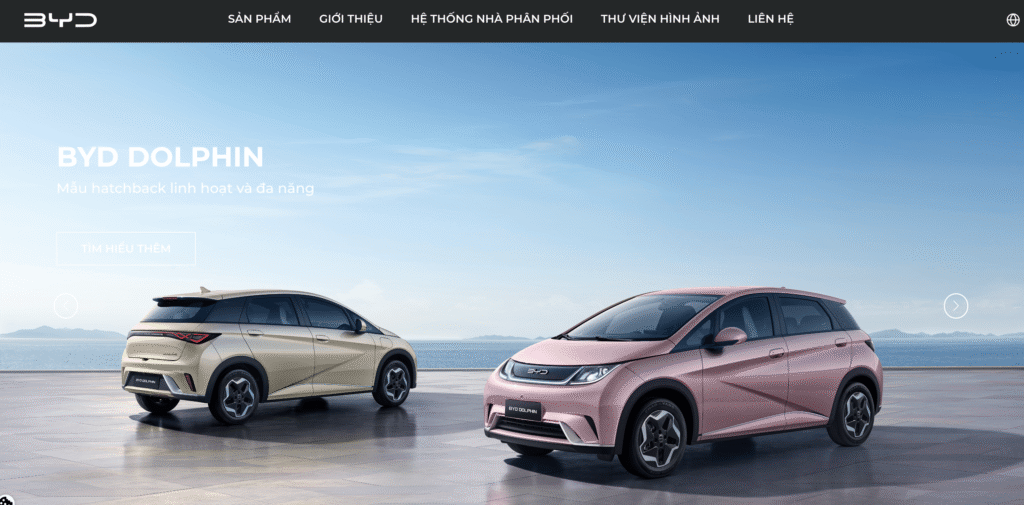
As one of the world’s foremost electric vehicle manufacturers, BYD (Build Your Dreams) has embarked on a calculated and ambitious expansion into Vietnam’s emerging EV landscape. Leveraging its global leadership in EV innovation, production scale, and battery technology, BYD is positioning itself as a serious contender in Vietnam’s rapidly evolving clean mobility market. Its strategic localization plans, diversified product lineup, and aggressive dealership rollout have collectively made BYD a top 10 EV brand in Vietnam in 2025.
1. Market Entry Strategy and Expansion Roadmap
1.1 Timeline and Milestones
- Official Market Launch: July 2024 marked BYD’s formal entry into the Vietnamese market.
- Initial Product Launch: Introduction of three flagship models – the Dolphin hatchback, Atto 3 SUV, and Seal sedan.
- Model Pipeline: Planned expansion to six models by Q4 2024, targeting multiple consumer demographics.
1.2 National Dealership Rollout
| Phase | Number of Outlets | Target Cities | Timeline |
|---|---|---|---|
| Initial Launch | 10 showrooms | Hanoi, Ho Chi Minh City | July 2024 |
| Medium-Term Expansion | 50 dealerships | Tier-1 & Tier-2 urban centers | End of 2025 |
| Long-Term Expansion | 100 dealerships | Nationwide (urban + suburban) coverage | Within 3 years (2027) |
1.3 Localization and Production Strategy
- Current Imports: All models are imported as Completely Built Units (CBUs) from BYD’s Thailand-based facility.
- Future Local Assembly Plans:
- Actively in discussions with Vietnamese provincial governments to explore land and incentives.
- Intent to establish a domestic assembly plant, optimizing costs and enhancing market competitiveness.
1.4 Vision for Vietnam
- BYD aims to foster a green transportation ecosystem, integrating clean energy solutions with affordable, high-performance electric vehicles.
- Its broader mission aligns with Vietnam’s net-zero goals by 2050 and targets to decarbonize urban transport.
2. Diverse Model Lineup and Competitive Pricing
BYD’s vehicle offerings in Vietnam are designed to serve a broad spectrum of buyers—from entry-level urban commuters to tech-savvy professionals.
2.1 Model Specifications and Features
| Model | Segment | Starting Price (VND) | Range (WLTP) | Battery Specs | Performance Highlights |
|---|---|---|---|---|---|
| Dolphin | Hatchback | 659 million | 262 miles | LFP Blade Battery (44.9 kWh est.) | Compact, urban-focused, ~210 real miles |
| Atto 3 | Compact SUV | 786M (Dynamic) / 886M (Premium) | 261 miles | LFP Blade Battery (60.48 kWh) | 150 kW motor, stylish and practical |
| Seal | Sedan (Premium) | 1.12B (Advanced) / 1.36B (Performance) | Up to 570 km | Dual-motor, 82.6 kWh LFP Blade | 0–100 km/h in 3.8 seconds |
Note: Pricing is competitive compared to other imported EVs and slightly undercuts many premium European or American electric models.
2.2 Warranty and Ownership Incentives
- Vehicle Warranty: 6 years or 150,000 km.
- Battery & Drive Unit: 8 years or 160,000 km.
- Loan Financing Programs: Strategic tie-ups with BIDV, VPBank, and VietinBank offering:
- Up to 85% vehicle financing.
- Preferential interest rates for EV buyers.
3. Consumer Experience and Vehicle Reception
3.1 Positive Market Feedback
- Design Aesthetics: Praised for modern styling and high-quality cabin materials.
- Interior Quality: Vehicles like the Seal and Han EV offer premium interiors with:
- Dual laminated acoustic glass
- Advanced infotainment systems
- Smart ergonomic layouts
3.2 Performance and Driveability
- Smooth Ride Quality: BYD vehicles are noted for refined suspension and quiet cabin dynamics.
- Advanced Safety Suite: Equipped with ADAS systems, though some users found them overly sensitive.
3.3 Key Criticisms
| Area | Feedback |
|---|---|
| Ride Sophistication | Some models, particularly Seal, lack suspension finesse |
| Safety Systems | Driver-assist features occasionally trigger false alerts |
| Brand Recognition | Relatively new in Vietnam; buyers may hesitate on resale value |
4. Charging Infrastructure and Energy Strategy
Unlike domestic players such as VinFast, BYD has taken a partner-first approach to charging access rather than building a proprietary network.
4.1 BYD’s Charging Strategy
- No Dedicated Charging Network (as of mid-2025).
- Relies on:
- Third-party charging providers
- Home charging systems
- Dealership-based charging facilities
4.2 Market Challenges
| Advantage | Limitation |
|---|---|
| Focus on low-cost model access | Lack of direct control over charging speed and availability |
| Leverages existing infrastructure | Slower nationwide charging rollout compared to local peers |
- BYD Vietnam’s Communications Director acknowledged the gap and highlighted ongoing partnerships with top local providers.
5. Why BYD is Among the Top 10 EV Brands in Vietnam (2025)
| Core Advantage | Explanation |
|---|---|
| Global Scale & Experience | World’s largest EV producer with proven reliability and battery leadership |
| Aggressive Pricing Strategy | BYD offers competitive pricing across hatchbacks, SUVs, and sedans |
| Diverse Product Portfolio | Serves entry-level, mid-tier, and performance-conscious segments |
| Rapid Dealership Expansion | Presence in key cities and future network of 100 showrooms improves accessibility |
| Sustainable Vision | Strategic alignment with Vietnam’s green mobility goals and local job creation |
Conclusion
BYD’s strategic foray into Vietnam marks the beginning of what could be a transformative chapter in the country’s electric mobility journey. With a future-oriented product roadmap, aggressive pricing, and credible consumer interest, BYD stands out as one of the most impactful international EV players in Vietnam. Despite infrastructure-related constraints, its growing local partnerships and planned production investments are likely to solidify its competitive edge in the years to come.
3. Hyundai
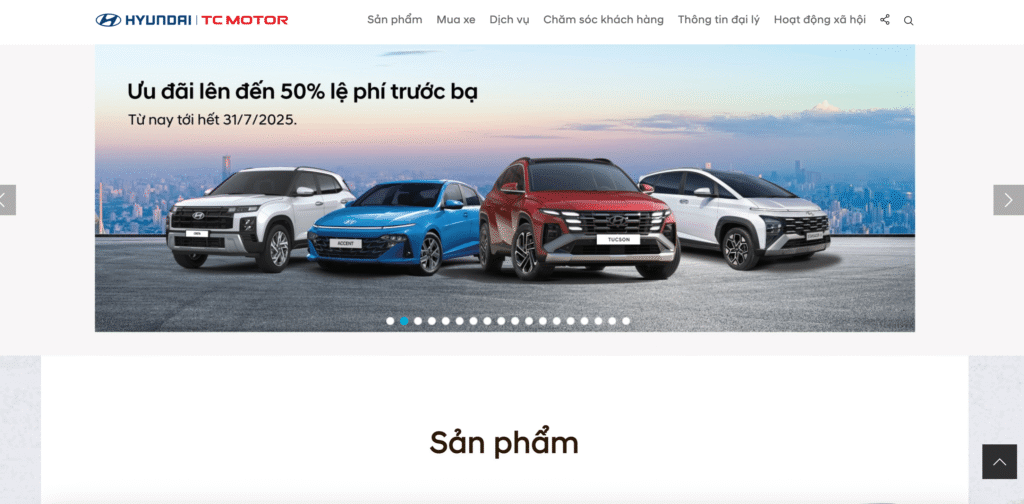
Hyundai Motor Company, one of the world’s leading automakers, continues to solidify its foothold in the Vietnamese market by strategically expanding its electrified vehicle portfolio. Leveraging global innovation, local assembly, and a growing infrastructure ecosystem, Hyundai has become a central figure in Vietnam’s transition to electric mobility. Its thoughtful approach to pricing, manufacturing, and after-sales support has positioned the brand as one of the Top 10 EV manufacturers in Vietnam for 2025.
1. Market Position and Electrification Strategy
1.1 Strong Market Presence in Vietnam
- Hyundai held a commanding 14% share of Vietnam’s total automobile market in 2024, ranking it among the top-selling automotive brands.
- It continues to benefit from early mover advantage in key urban regions like Hanoi, Ho Chi Minh City, and Da Nang, where demand for electrified vehicles is accelerating.
1.2 Electrification Focus
- Hyundai’s EV strategy in Vietnam targets accessible price points, aiming to make electric mobility mainstream across multiple demographic segments.
- In addition to battery electric vehicles (BEVs), Hyundai is also one of the few brands actively pushing hybrid and plug-in hybrid electric vehicles (HEVs & PHEVs) as transitional options for Vietnamese consumers.
1.3 Strategic Rationale
- As international brands eye Vietnam for long-term growth, Hyundai’s local production, pricing competitiveness, and product range give it a unique advantage.
- The brand is expected to be a key contributor to national EV adoption goals by 2025, especially in the mid-to-premium segment.
2. Key EV Model: IONIQ 5 and Local Assembly
2.1 Local Production Milestone
- Hyundai IONIQ 5 is the first fully electric model from Hyundai assembled locally in Vietnam through its joint venture with Hyundai Thanh Cong Vietnam (HTV).
- This strategic localisation aligns with Vietnam’s industrial policy, which prioritises domestic production to reduce import dependency and encourage technology transfer.
2.2 IONIQ 5: Specifications and Features
| Specification | Details |
|---|---|
| Model | Hyundai IONIQ 5 |
| Assembly Location | HTV Plant, Ninh Binh, Vietnam |
| Charging Capacity | 2.5 kW AC (standard) |
| Estimated Range (EPA) | Up to 318 miles (RWD variant) |
| Starting Global MSRP | $42,600 |
| Global Availability | 40+ countries including Vietnam |
| Body Type | Crossover SUV |
- The IONIQ 5 is positioned as a premium yet practical urban EV, balancing range, performance, and futuristic styling.
- It appeals to environmentally conscious families and tech-oriented professionals alike.
2.3 Customer Experience and Reviews
| Positive Attributes | Areas for Improvement |
|---|---|
| High build quality | Large turning radius |
| Comfortable and whisper-quiet interior | Sensitive blind spot monitoring |
| Strong electric performance on flat terrain | Power loss on steep gradients (reported) |
3. Charging Infrastructure and After-Sales Ecosystem
3.1 Strategic Partnership with ABB
- Hyundai has partnered with ABB, a global leader in electrification technology, to offer Terra AC Wallbox chargers to IONIQ 5 buyers.
- These home charging solutions offer:
- Safe and efficient overnight charging
- Customizable installation to fit residential electrical systems
- Smart energy management features
3.2 Dealership-Based Charging Network
- Charging support is further enhanced by in-dealership charging stations, addressing a critical barrier to EV adoption.
- Hyundai’s EV-ready dealerships provide:
- Routine charging services during maintenance visits
- Dedicated fast-charging bays for test drives and customer convenience
3.3 Broader Service Ecosystem
- Hyundai’s post-sales services are integrated into its national dealership network, with trained EV technicians and battery diagnostics tools.
- ABB chargers are also installed in multi-brand service centers, expanding the EV support network across the country.
4. Hyundai’s Competitive Position in Vietnam’s EV Market (2025)
| Key Pillar | Explanation |
|---|---|
| Local Assembly | Reduces cost, qualifies for local incentives, and builds brand trust |
| Strategic Partnerships | Collaborations with ABB and HTV strengthen infrastructure and production support |
| Product Reliability | Global reputation for durability and premium build quality |
| Dealer Network | Strong national dealership presence ensures accessibility and support |
| Diverse Electrified Range | Combines BEVs with hybrids to offer flexibility to consumers |
4.1 Hyundai vs Competitors (EV Ecosystem Readiness)
| Metric | Hyundai | VinFast | BYD |
|---|---|---|---|
| Local Assembly | Yes (IONIQ 5) | Yes | Planned (Not Yet) |
| Charging Network | Partnered (ABB) | Proprietary | Third-Party Only |
| After-Sales Support | Extensive | Strong | Developing |
| Entry-Level EV Offering | No (Yet) | Yes (VF3, VF5) | Yes (Dolphin) |
| Luxury EV Model | Yes (IONIQ 5) | Yes (VF9) | Yes (Seal) |
5. Conclusion: Why Hyundai is One of Vietnam’s Top 10 EV Brands in 2025
Hyundai’s prominence in Vietnam’s automotive landscape is the result of long-term strategic investments, technological leadership, and consumer trust. Its ability to integrate global EV innovations with local assembly and service partnerships gives it a unique edge as Vietnam accelerates toward a greener future. Although the brand has yet to launch entry-level BEVs in Vietnam, its strong presence in the mid-to-premium segment and comprehensive charging support make Hyundai a key player in the national EV transformation.
4. MG
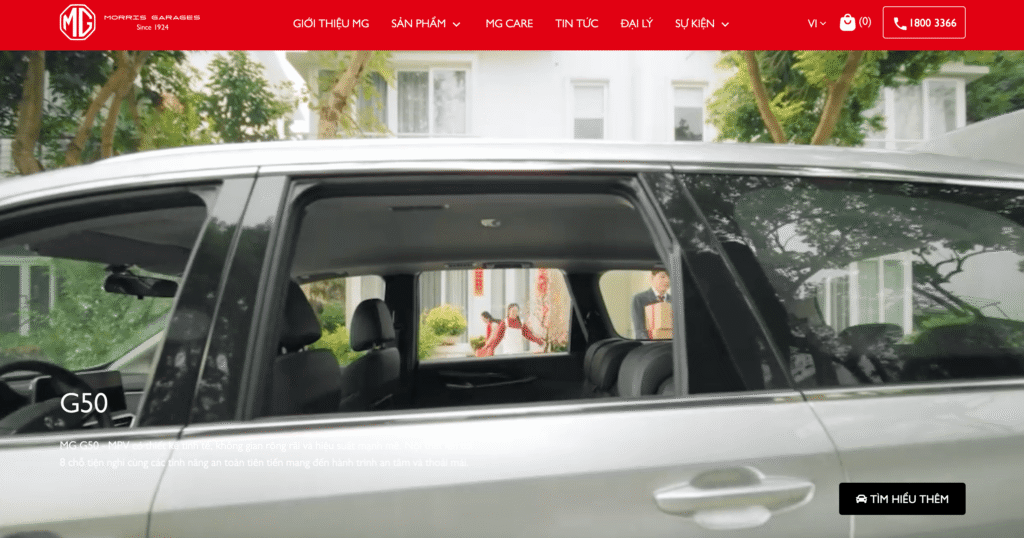
MG Motor, a historic British automotive marque now under the ownership of SAIC Motor Corporation, one of China’s leading state-owned automotive manufacturers, is emerging as a formidable competitor in Vietnam’s fast-growing electric vehicle (EV) market. Backed by SAIC’s global scale, MG’s focus on affordable, tech-forward, and performance-oriented EVs has quickly gained traction among Vietnamese consumers seeking accessible clean mobility solutions.
1. Strategic Market Entry and Growth Trajectory
1.1 Launch Timeline and Strategic Intent
- Official EV Launch Date: June 1, 2024 — introduction of the MG4 EV to the Vietnamese market.
- Initial Market Visibility: First revealed to Vietnamese audiences during the Vietnam Motor Show 2022, indicating early intent to enter the EV segment.
- MG is part of the second wave of international EV entrants, capitalizing on the evolving consumer demand for cost-effective electrified transportation.
1.2 Anticipated Role in EV Market Expansion
- Recognized as a key brand expected to drive EV and hybrid adoption by the end of 2025.
- MG’s entry comes at a pivotal time, as Vietnam seeks to rapidly scale EV adoption in both the private and fleet segments.
2. Model Portfolio and Competitive Market Positioning
2.1 Flagship EV: MG4
| Version | Battery Capacity | Range (NEDC) | Price (VND) | Key Features |
|---|---|---|---|---|
| DEL | 51 kWh | 350 km | 828 million (~$32,670) | Budget-friendly, smart urban driving features |
| LUX | 64 kWh | 450 km | 948 million | Extended range, premium infotainment system |
- Based on SAIC Motor’s Modular Scalable Platform (MSP):
- 50:50 weight distribution for better road balance.
- Low center of gravity improving cornering and handling at speed.
- Suitable for both city commuting and intercity travel.
2.2 Complementary Model: MG ZS EV
| Model | Powertrain | Positioning | Global Performance |
|---|---|---|---|
| ZS EV | Battery Electric | Compact crossover for families | Best-selling MG model in global EV markets |
| ZS Petrol | Internal Combustion | Budget SUV offering | Priced from VND 518M to 588M in Vietnam |
- While local EV sales data for ZS EV remain undisclosed, MG’s decision to retain this model reinforces its dual-path strategy: promoting both electric and ICE-based options to ensure wide accessibility.
3. Customer Experience, Design Reception, and Performance Reviews
3.1 Noteworthy Consumer Praise
| Category | Positive Feedback |
|---|---|
| Design & Aesthetics | Sporty, modern appearance appealing to younger demographics |
| Interior Comfort | Spacious cabin layout with intuitive digital interface |
| Technology Features | Smooth infotainment response, advanced driving assists (ACC, Traffic Jam Assist) |
- The MG4 EV is often compared favorably to competitors like the Hyundai IONIQ 5, offering similar tech benefits at a more accessible price point.
3.2 Identified Challenges
| Limitations | User Commentary |
|---|---|
| Cold-Weather Range | Range drops during colder temperatures (typical for EVs globally) |
| Charging Speed | Slower compared to fast-charging competitors |
| Brand Familiarity | MG still building trust compared to legacy Japanese or Korean players |
4. Charging Ecosystem and After-Sales Service Infrastructure
4.1 Charging Support: MG Super Charge
- MG has developed a dedicated fast-charging network:
- Branded as MG Super Charge.
- Chargers can be located, booked, and monitored via the i-SMART mobile app.
- Designed for easy integration into both residential and public environments.
4.2 Mobile and Warranty-Based Services
| Service Feature | Details |
|---|---|
| Mobile Service Accessibility | Available both in-warranty and out-of-warranty periods |
| Scheduled Maintenance Options | Service timeframes offered at 60, 90, and 120-minute durations |
| Body & Paint Repairs | Minor cosmetic repairs guaranteed within 24 hours |
- These offerings enhance customer trust and reduce vehicle downtime, making MG a practical choice for daily commuters and families.
5. MG’s Strategic Advantages in the Vietnamese EV Market
| Competitive Pillar | Strategic Value Proposition |
|---|---|
| Affordability | Among the lowest price points in the market for long-range EVs |
| Modular Platform Architecture | Scalable, future-proof design supporting better efficiency and smoother driving |
| Local Assembly (Future Focus) | Ongoing discussions under SAIC’s ASEAN strategy to establish regional production hubs |
| Digital Integration | Connected experience via i-SMART app improves charging, maintenance, and user interface |
| After-Sales Commitment | Mobile servicing, guaranteed repair turnaround, and charging support |
5.1 Market Positioning Matrix: MG vs Key Competitors
| Brand | Entry Price (VND) | Range (Max) | Charging Network | Local Assembly | Mobile Service |
|---|---|---|---|---|---|
| MG | 828M | 450 km | MG Super Charge | Not yet | Yes |
| VinFast | 523M (VF3 est.) | 500+ km (VF8+) | Proprietary national grid | Yes | Yes |
| BYD | 659M (Dolphin) | 570 km (Seal) | Third-party partnerships | In planning | Limited |
| Hyundai | 1B+ (IONIQ 5) | 500+ km | Partnered (ABB) | Yes | Yes |
6. Conclusion: Why MG Ranks Among the Top 10 EV Brands in Vietnam (2025)
MG’s successful launch of the MG4 EV and its future-oriented strategy backed by SAIC Motor have allowed it to capture the attention of price-sensitive and tech-savvy Vietnamese buyers. Through a combination of attractive pricing, practical range, modular engineering, and value-driven after-sales service, MG has carved a unique niche in a crowded market. Although relatively new in Vietnam, the brand’s growing reputation, expanding charging network, and customer-centric service model indicate strong potential for continued growth and deeper market penetration in the coming years.
5. Kia
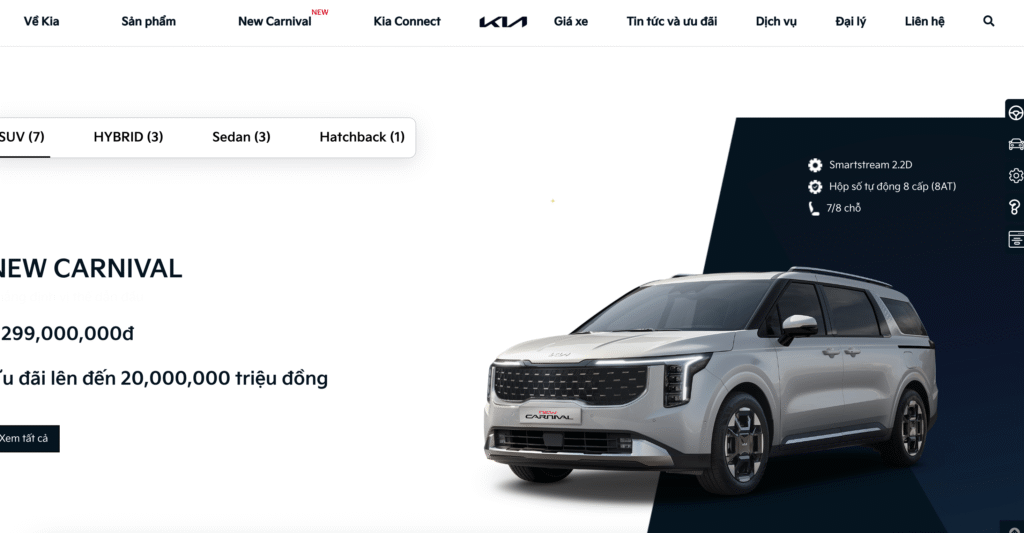
Kia Corporation, a global automotive innovator headquartered in South Korea, is steadily enhancing its position within Vietnam’s rapidly evolving electric vehicle (EV) ecosystem. As sustainability becomes a national agenda and consumer preferences shift toward eco-conscious mobility, Kia has emerged as a top-tier international brand actively contributing to the transformation of Vietnam’s green transport sector in 2025.
1. Market Penetration Strategy and Regional Expansion
1.1 Strategic Market Positioning in Vietnam
- Kia is one of the prominent automakers shaping the Vietnamese electric and hybrid vehicle market in 2025.
- The brand is capitalizing on Vietnam’s increasing demand for green mobility solutions, leveraging its global experience and local production capabilities.
- Alongside Hyundai, Kia has invested in localized production hubs in Vietnam, reducing logistical costs and aligning with the government’s localization policies.
- By establishing production within the country, Kia enhances its agility to respond to Vietnamese market preferences and regulatory frameworks.
1.2 Global Growth as a Foundation for Vietnamese Strategy
- In June 2025, Kia recorded global sales of 269,652 units, reflecting a 0.2% year-on-year increase.
- For the first half of 2025, Kia achieved its highest-ever sales performance, with 1,587,161 units sold worldwide, up 2% compared to H1 2024.
- This global momentum is partly attributed to the successful introduction of new EV models like:
- Kia EV3 (electric SUV)
- Kia EV4 (electric sedan)
- These international achievements provide a strong platform for Kia’s strategic initiatives in Southeast Asia, including Vietnam.
2. Electric Vehicle Lineup and Consumer Appeal
2.1 Flagship EV Model: Kia EV6
- The Kia EV6, launched globally in 2021, remains the brand’s cornerstone in the fully electric mid-size SUV segment.
- In H1 2025 alone, Kia sold 5,875 EV6 units globally, a strong indicator of consumer confidence.
- The model integrates a cross-category design blending SUV practicality with coupe sportiness.
| Feature Category | Details |
|---|---|
| Battery and Range | Up to 310 miles per charge (EPA-estimated for RWD models) |
| Charging Capability | Ultra-fast 800V charging system (10–80% in under 18 minutes) |
| Performance and Drive | Available in AWD variants; smooth regenerative braking |
| Interior | Spacious cabin with flat floor; dual 12.3” panoramic displays |
| Awards and Recognition | 2022 European Car of the Year; iF Design and Red Dot Awards |
2.2 Consumer Perception and User Feedback
- Pros:
- Sporty, futuristic exterior design
- Advanced driver-assistance systems (ADAS)
- Quiet cabin and robust build quality
- Youthful brand identity aligned with next-gen buyers
- Cons (Minor):
- Touch-sensitive HVAC controls can be unintuitive
- Rear headroom may be limited for tall passengers
3. Charging Ecosystem and After-Sales Services
3.1 Global Charging Infrastructure Blueprint
- Through its “Kia Charge” initiative in Europe, Kia provides access to 500,000+ charging points across 28 countries via a single RFID-based network.
- While this initiative is European-focused, it demonstrates Kia’s capability and commitment to scaling charging infrastructure across new markets, including Vietnam.
3.2 Charging Solutions in Vietnam (Expected)
- In Vietnam, Kia is expected to replicate successful global models by:
- Deploying dealership-integrated charging stations
- Exploring collaborations with Vietnamese infrastructure providers
- Introducing mobile-based apps to help users locate charging stations and schedule services
3.3 After-Sales Excellence and Maintenance Support
| Service Component | Specification |
|---|---|
| Battery Warranty | Up to 10 years or 200,000 km for lithium-ion packs |
| Scheduled Maintenance | Every 10,000 km or 6 months, whichever comes first |
| Diagnostic Services | Available at authorized Kia service centers |
| Warranty Scope | Includes EV-specific components like inverters and motors |
| Emergency Support & Mobile Repair | Available in key metropolitan zones |
- Kia’s maintenance network in Vietnam includes certified service centers that provide diagnostics, genuine parts, and EV-certified technicians.
- The brand emphasizes customer-centric support, offering digital servicing appointments and real-time tracking of service statuses.
4. Competitive Positioning in Vietnam’s 2025 EV Market
Kia’s Competitive Strength Matrix
| Evaluation Criteria | Kia’s Performance |
|---|---|
| Local Production | Yes (Joint assembly with Hyundai in Vietnam) |
| Charging Infrastructure | Moderate (Expected dealership support and third-party tie-ups) |
| EV Portfolio Diversity | High (EV6 available; EV3 & EV4 anticipated) |
| Brand Reputation | Strong (Proven globally, growing in Vietnam) |
| Price-to-Performance | Competitive in premium EV segment |
SEO-Optimised Summary for 2025
- Kia’s strategic investments in local production, combined with its internationally acclaimed EV models like the EV6, position the brand as a frontrunner in Vietnam’s electrified mobility sector.
- With a well-rounded value proposition that includes stylish design, long-range capabilities, fast-charging features, and comprehensive after-sales support, Kia is well-equipped to meet the evolving needs of Vietnamese EV consumers.
- As Vietnam scales its green mobility infrastructure and incentives, Kia stands out as one of the Top 10 Electric Vehicle Brands in Vietnam in 2025 due to its adaptability, innovation, and customer-first approach.
6. Mercedes-Benz
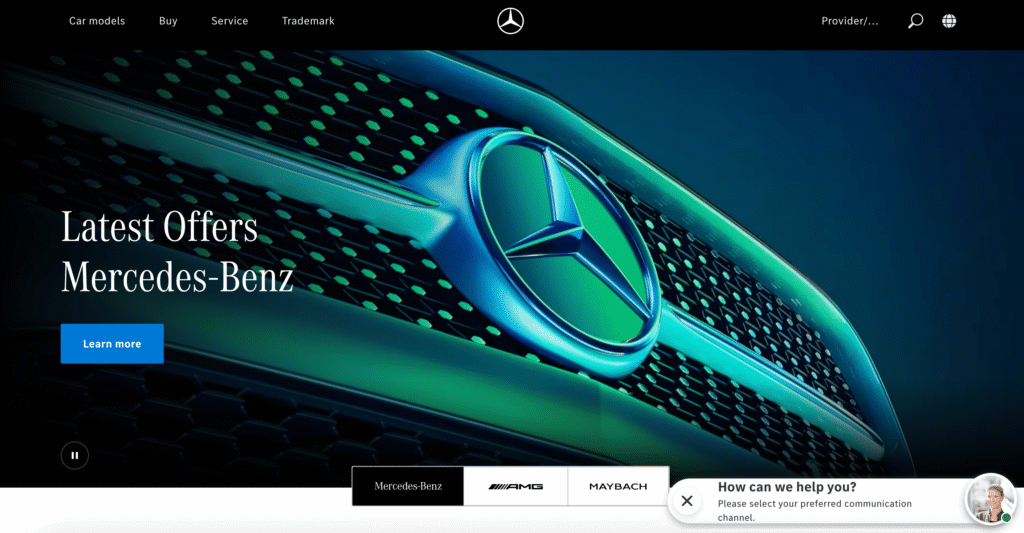
Mercedes-Benz, the globally renowned German luxury automobile manufacturer, is actively redefining the high-end electric vehicle (EV) experience in Vietnam. Through its dedicated electrification roadmap and introduction of state-of-the-art EQ models, Mercedes-Benz Vietnam (MBV) has solidified its standing as a pioneering brand in Vietnam’s luxury EV segment in 2025.
1. Strategic Market Entry and Premium Positioning
1.1 Brand Commitment to Electrification in Vietnam
- Mercedes-Benz Vietnam has executed a strategic rollout of three fully electric SUVs—the EQB, EQE, and EQS—since 2023, underscoring its deep commitment to electrification in emerging markets.
- The brand leverages its global design, engineering, and performance excellence to capture affluent Vietnamese consumers seeking premium, sustainable mobility.
1.2 Market Share and Targeted Penetration
- While European brands captured approximately 3% of Vietnam’s total auto market in 2024, this segment translated to nearly 8,000 new vehicle registrations, indicating a robust and growing luxury EV niche.
- Mercedes-Benz’s focus is not on volume but on dominating the high-margin, premium EV sector, particularly in major urban centers like Hanoi, Ho Chi Minh City, and Da Nang, where luxury consumption is rising.
2. EQ Series: Benchmarking Performance and Innovation
Mercedes-Benz’s EQ lineup is carefully tailored to cater to varying customer profiles within the premium market, offering a combination of luxury, cutting-edge technology, and advanced powertrains.
2.1 Model Lineup Overview
| Model | Segment | Powertrain | Range (km/miles) | Acceleration (0-100 km/h) | Key Features |
|---|---|---|---|---|---|
| EQB SUV | Compact Luxury SUV | Dual Motor EV | Up to 473 km (WLTP) | 8.9 seconds | 7-seater, Smart Storage, Versatile Cabin |
| EQE Sedan | Mid-size Executive Sedan | RWD 350+ w/ 96kWh | 308 miles (EPA est.) | 6.2 seconds | Aerodynamic Styling, Mercedes Voice Assistant |
| EQS 580 4MATIC Sedan | Flagship Luxury Sedan | Dual Motor, 536 hp | Over 600 km (WLTP) | 4.2 seconds | MBUX Hyperscreen, Rear 31.3” TV, Massage Seats |
2.2 Innovation Highlights
- MBUX Hyperscreen: A revolutionary digital interface stretching 56 inches across the dashboard, available on the EQS.
- Customizable User Profiles: AI-based user experience that adapts preferences for seat, temperature, and infotainment.
- Energy Recuperation Systems: Intelligent regenerative braking and route-optimized energy consumption systems.
- Interior Ambience: Use of sustainable materials, ambient lighting, and advanced sound insulation.
3. Global Context and Local Potential
3.1 International Sales Context (Q2 2025)
| Segment | Global Sales (Q2 2025) | % Change YoY |
|---|---|---|
| Battery EVs | 35,000 units | -24% |
| Plug-in Hybrids | 6,900 units | +34% |
| Total EV Sales | 41,900 units | -18% |
- Despite a softening global demand for premium BEVs due to economic conditions and EV saturation in developed markets, Mercedes-Benz sees Vietnam as a high-growth frontier where luxury EV adoption is still in its early stages and supported by local incentives.
3.2 Why Vietnam Remains a Strategic EV Frontier
- Growing Affluent Class: Rising HNWI (High Net-Worth Individual) population in Vietnam fuels demand for exclusive, tech-forward vehicles.
- Favorable Luxury Tax Policies: Government incentives and special consumption tax exemptions for EVs enhance affordability in the premium bracket.
- Urbanization and Smart City Development: EVs align with smart infrastructure plans in Vietnam’s tier-1 cities.
4. Charging Infrastructure and Premium Service Experience
Mercedes-Benz’s post-sale services and EV infrastructure support reinforce its brand promise of luxury, convenience, and reliability.
4.1 Planned Charging Network in Vietnam
| Location Type | Charging Access Strategy |
|---|---|
| Mercedes-Benz Showrooms | DC fast chargers integrated at official dealers |
| 5-Star Hotels & Resorts | Collaborations with premium hospitality chains |
| Upcoming EV Hubs | Participation in public-private charging infrastructure |
- MBV plans to deploy dedicated EV charging stations at 16 official distributor and service locations, ensuring nationwide coverage.
- Premium partnerships with luxury hotels and resorts ensure that EV drivers maintain convenience during travel or leisure stays.
4.2 Global Benchmarking: International Partnerships
While in Vietnam the infrastructure is still under development, globally, Mercedes-Benz has partnered with:
- Starbucks
- Simon Malls
- Buc-ee’s
These partnerships illustrate the brand’s proactive approach to making charging integrated into daily premium lifestyles—a model that MBV may localize for Vietnamese clientele.
4.3 After-Sales and Ownership Experience
| Feature | Mercedes-Benz Offerings |
|---|---|
| Warranty Coverage | Up to 10 years on high-voltage EV components |
| Digital Service Scheduling | Mobile app integration with service appointment slots |
| EV Diagnostic & Repairs | Certified high-voltage technicians at official centers |
| Exclusive Concierge Services | Vehicle pickup and delivery for elite clients |
5. Competitive Positioning in Vietnam’s Luxury EV Segment
Mercedes-Benz Brand Matrix
| Evaluation Dimension | Mercedes-Benz Vietnam (2025) |
|---|---|
| Brand Equity & Legacy | Exceptionally High – Synonymous with luxury |
| EV Technology Integration | High – AI, digital cockpit, Hyperscreen innovations |
| Charging Network Development | Moderate – Actively expanding through premium partners |
| Price Positioning | Premium – Tailored to high-net-worth demographics |
| After-Sales Network Strength | Strong – Nationwide official servicing partners |
SEO-Optimised Summary: Why Mercedes-Benz Is Among the Top 10 EV Brands in Vietnam (2025)
- Mercedes-Benz has firmly positioned itself as a pioneer in Vietnam’s luxury electric vehicle segment, through its early market entry, technology-rich EQ models, and strategic charging and service infrastructure.
- By targeting a high-value clientele with models like the EQB, EQE, and EQS, the brand delivers an unparalleled EV experience combining performance, luxury, and sustainability.
- As Vietnam’s EV market matures, Mercedes-Benz is uniquely poised to capture leadership in the premium electric mobility space, distinguishing itself through innovation, heritage, and elite ownership experience.
7. BMW
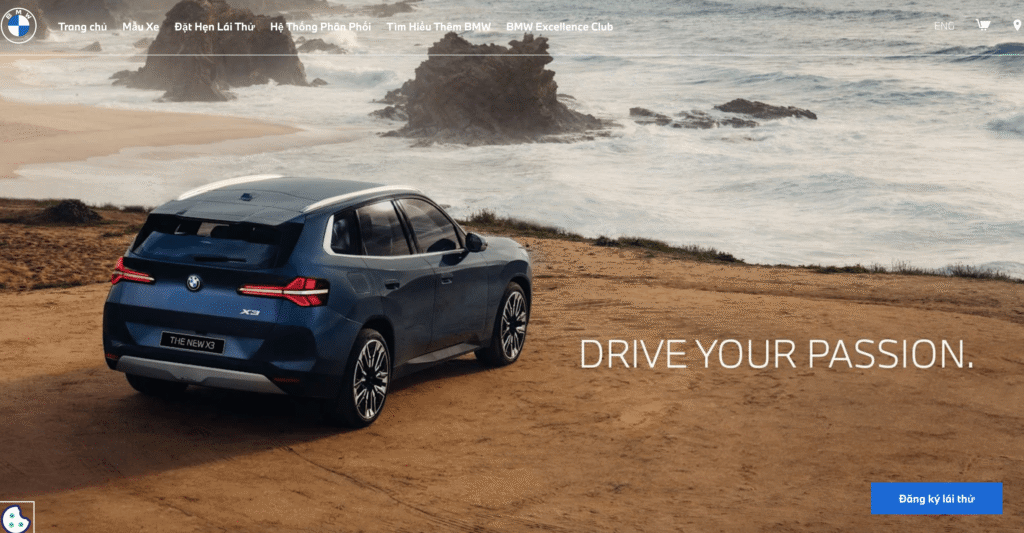
As Vietnam’s electric vehicle (EV) industry evolves, BMW stands out as one of the most influential luxury automakers driving the high-end segment forward. With a globally renowned reputation for performance, engineering excellence, and innovation, BMW is leveraging its premium electric “i-Series” portfolio to cater to a growing cohort of affluent Vietnamese consumers. Backed by a strategic local partnership with THACO AUTO and targeted infrastructure development, BMW’s presence in Vietnam’s electric mobility sector is both deliberate and impactful.
1. Market Strategy and Brand Trajectory
Strategic Positioning in the Vietnamese Luxury EV Landscape
- BMW is strategically targeting Vietnam’s expanding luxury car market, focusing on premium electric offerings under its “i-Series.”
- European luxury brands (including BMW) captured a combined 3% market share in 2024, representing around 8,000 new vehicle registrations.
- BMW’s market entry is distinguished by:
- Exclusive positioning of its electric models at the upper end of the price spectrum.
- Brand recognition associated with German automotive craftsmanship.
- Local distribution through THACO AUTO, facilitating nationwide service and access.
Global Momentum Fuelling Regional Confidence
- BMW Group sold 426,536 battery-electric vehicles (BEVs) globally in 2024, up 13.5% YoY.
- Pure EVs now account for 17.4% of the brand’s total deliveries worldwide.
- While Q2 2025 saw a global BEV sales dip of 21.2%, key models like the i4 experienced a 10.7% YoY growth, underlining model-specific resilience.
2. BMW i-Series EV Portfolio in Vietnam
BMW’s electric range in Vietnam reflects the brand’s emphasis on luxury, high-performance, and advanced technology. The lineup includes SUVs and sedans tailored for customers prioritizing premium aesthetics and innovation.
| Model | Starting Price (VND) | Estimated USD | WLTP Range (km) | Acceleration (0–100 km/h) |
|---|---|---|---|---|
| BMW iX3 | 3,539,000,000 | ~$139,500 | Up to 461 km | ~6.8 seconds |
| BMW i4 | 3,799,000,000 | ~$149,800 | Up to 590 km | 5.7 seconds |
| BMW i7 xDrive60 | 6,799,000,000 | ~$268,200 | 591–625 km | 4.7 seconds |
Key Features of the i-Series Models
- Fifth-generation eDrive technology for better efficiency and performance.
- High energy density lithium-ion battery packs.
- Modern cabin design with immersive digital cockpit displays and sustainable materials.
- Top-tier safety and driver assistance systems, including lane-keeping assist and adaptive cruise control.
3. EV Charging Infrastructure and Service Assurance
Charging Station Rollout by THACO AUTO
BMW, in collaboration with local partner THACO AUTO, is expanding EV infrastructure to meet rising demand.
| Location | Charger Type | Charging Speed | Coverage |
|---|---|---|---|
| Ho Chi Minh City | DC Fast (120 kW) | 0–80% in 30 mins | Available |
| Binh Duong | DC Fast (120 kW) | 0–80% in 30 mins | Available |
| Hanoi | DC Fast (120 kW) | 0–80% in 30 mins | Available |
| Planned Expansion (2025) | 6 additional cities | ~ | Target: 9 nationwide |
- Free charging access for BMW iX3, i4, and i7 owners at THACO-operated stations.
- Additional plans may include integration with third-party providers or hotels for wider accessibility.
After-Sales Support and Warranty Programs
BMW’s after-sales service is engineered to match its luxury vehicle standards:
- “BMW Service Inclusive” packages:
- Covers services such as microfilter replacement, brake fluid, routine checks, and EV battery diagnostics.
- Standard validity: 6 years with no mileage limit, extendable to 10 years.
- Battery warranty:
- Long-term coverage for electric drivetrain and battery health.
- Customer experience support:
- Personalized consultations, test drives, and digital service appointment booking.
4. Why BMW is a Top EV Brand in Vietnam in 2025
BMW’s ranking among Vietnam’s Top 10 Electric Vehicle Brands in 2025 is underpinned by a combination of strategic market entry, tailored luxury offerings, and superior service infrastructure.
| Factor | BMW’s Strength |
|---|---|
| Product Portfolio | High-end EV models (iX3, i4, i7) with cutting-edge specs |
| Market Positioning | Focus on affluent urban consumers seeking luxury sustainability |
| Charging Infrastructure | Nationwide DC fast-charging expansion by THACO AUTO |
| After-Sales & Warranty | Comprehensive maintenance packages and long-term warranties |
| Brand Recognition | German engineering and premium brand legacy |
| Local Partnerships | Strong dealership and servicing network via THACO |
Conclusion: BMW’s Role in Vietnam’s Premium EV Evolution
BMW’s foray into Vietnam’s electric vehicle space signifies more than just brand expansion—it reflects a strategic commitment to shaping the luxury EV ecosystem in Southeast Asia. With a combination of technologically advanced vehicles, robust local infrastructure, and premium service, BMW offers a compelling value proposition to Vietnamese consumers seeking performance, status, and sustainability in one package. As the luxury EV segment matures, BMW is well-positioned to maintain a leadership role well beyond 2025.
8. Porsche
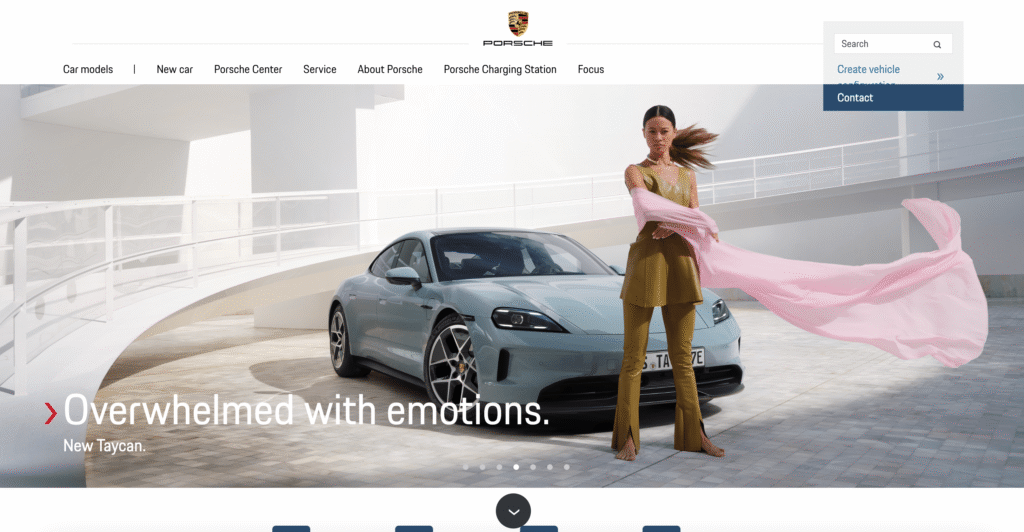
Porsche, the iconic German marque renowned for its engineering excellence and motorsport legacy, continues to maintain a distinguished but niche presence in Vietnam’s luxury electric vehicle (EV) market. In 2025, Porsche’s strategic positioning is centered around performance, exclusivity, and cutting-edge EV technology, notably through its flagship electric sports car—the Porsche Taycan. While the overall EV landscape in Vietnam is largely driven by affordability and practicality, Porsche carves out a significant foothold in the high-net-worth urban elite segment, driven by aspirations of high-performance, luxury-oriented green mobility.
Market Positioning and Strategic Focus
- Premium Segment Penetration
Porsche is part of the European luxury automaker cohort that jointly commanded about 3% of Vietnam’s automotive market share in 2024. While modest in volume, this segment exerts substantial influence due to its premium margins and strong brand equity. - Performance-Centric EV Strategy
The Porsche Taycan remains at the core of the brand’s electric portfolio in Vietnam. Its engineering focus aligns with Porsche’s brand DNA—delivering high-output electric propulsion, luxury finishes, and superior driving dynamics. - Global Headwinds and Strategic Recalibration
Despite its reputation, Porsche faced headwinds globally:- Taycan global deliveries fell 6% in H1 2025 to 8,302 units.
- In 2024, Porsche reported a 49% drop in Taycan sales, largely due to:
- Transition to updated model variants.
- Slower-than-anticipated consumer shift toward full EVs.
- In response, Porsche adjusted its electrification roadmap:
- Stepping back from its earlier 80% EV sales target by 2030.
- Redirecting part of its investment to hybrid and internal combustion engine (ICE) technologies, recognizing the nuanced pace of EV adoption across global markets.
Available EV Models and Pricing in Vietnam
Porsche offers a wide selection of Taycan variants in Vietnam, each tailored to varying performance expectations and luxury preferences.
| Model | Starting Price (VND) | Approx. USD | Power Output | 0-100 km/h Acceleration | Max Range (WLTP) |
|---|---|---|---|---|---|
| Taycan (Base) | 4,620,000,000 | $182,200 | 300 kW (408 PS) | 4.8 seconds | Up to 651 km |
| Taycan Turbo | 7,460,000,000 | $294,300 | 650 kW (884 PS) | 2.7 seconds | Up to 626 km |
| Taycan Turbo S | 8,990,000,000+ | $354,700+ | 750 kW (1,020 PS) | 2.6 seconds | ~620 km |
| Taycan Turbo GT | 9,510,000,000 | $375,000+ | ~760 kW | 2.3 seconds | Estimated 600+ km |
- Other available variants include Taycan 4, 4S, GTS, each offering different battery capacities, drivetrain options, and luxury trims.
- All models integrate advanced Porsche EV technologies such as 2-speed transmissions, adaptive air suspension, and over-the-air software updates.
Charging Infrastructure and Service Expansion
Porsche’s success in Vietnam’s EV market depends not only on its product offerings but also on its commitment to enhancing EV infrastructure and customer experience.
Strategic Charging Partnership with Charge+
| Key Initiative | Details |
|---|---|
| Partner | Charge+ (leading Southeast Asian charging provider) |
| High-Power DC Chargers Planned | 17 across 1,700 km of Vietnam’s highways |
| Completed Chargers by Mid-2025 | 9 stations (up to 180kW) in Hanoi, Ho Chi Minh City, Da Nang |
| Full Rollout Timeline | Remaining 8 chargers to be installed by mid-2027 |
| Existing Ultra-Fast Stations | Porsche Studio Hanoi & Porsche Saigon Centre (up to 350kW) |
| Digital Integration | All chargers integrated into the Charge+ App for seamless user access |
- This initiative aims to alleviate range anxiety for long-distance travel and enhance brand value among luxury EV consumers in Vietnam.
After-Sales and Brand Experience Centers
- Porsche operates two major service and brand experience facilities:
- Porsche Centre Saigon
- Porsche Centre Hanoi
- Services include:
- Dedicated EV maintenance bays
- On-site DC fast charging
- Personalized concierge-level after-sales service
Why Porsche Ranks Among Vietnam’s Top 10 EV Brands in 2025
- Exclusive Market Appeal: Despite relatively low sales volumes, Porsche’s high-end positioning and brand strength ensure consistent demand among Vietnam’s wealthy, status-driven clientele.
- Technology Leadership: Porsche remains a symbol of performance and innovation in EV engineering, even as it recalibrates its global strategy.
- Infrastructure Investment: Its collaboration with Charge+ reflects a long-term commitment to building a viable luxury EV ecosystem in Vietnam.
- Product Diversification: The wide array of Taycan variants, each targeting different luxury sub-segments, provides flexible entry points for consumers in the ultra-premium EV space.
Summary: Porsche’s Role in Vietnam’s E-Mobility Future
Porsche’s inclusion among the Top 10 Electric Vehicle Brands in Vietnam in 2025 is a testament to its ability to blend high-performance innovation with local market relevance. While its market share may remain niche, its impact on brand perception, technology standards, and premium infrastructure development contributes meaningfully to Vietnam’s broader EV transition. Porsche is not simply selling electric cars—it is redefining what electric luxury can mean in the Vietnamese automotive context.
9. Wuling
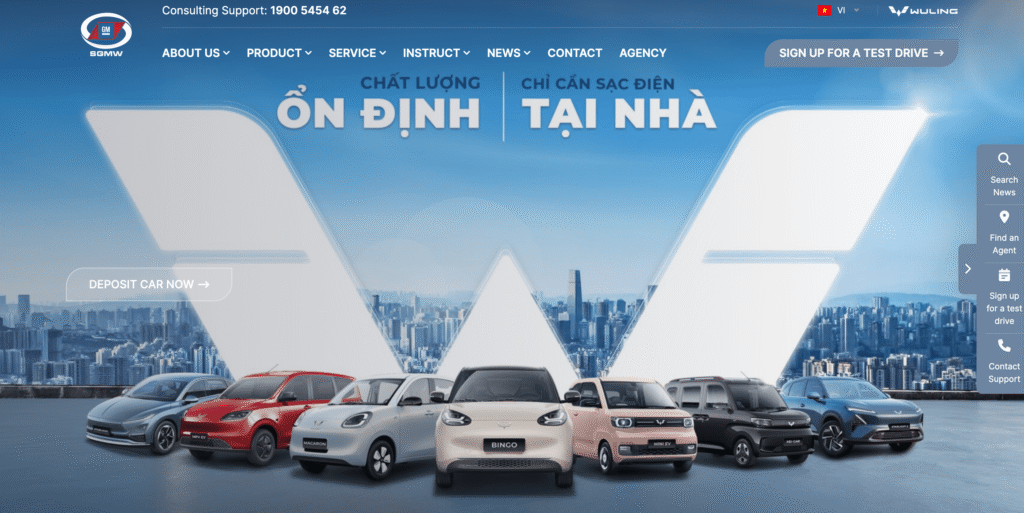
Wuling, a Chinese automotive brand under the SAIC-GM-Wuling joint venture, has emerged as a key disruptor in Vietnam’s electric vehicle (EV) industry by targeting the entry-level, ultra-affordable EV segment. Its localized strategy, centered on compact design, urban utility, and low price points, positions Wuling as a crucial player in democratizing e-mobility across Vietnam’s fast-urbanizing landscape.
Strategic Market Positioning
- Mass Accessibility Focus
Wuling’s success in Vietnam stems from a deliberate focus on affordability, simplicity, and functionality. In contrast to the high-end aspirations of many competitors, Wuling targets first-time car owners, low-income urban commuters, and cost-conscious consumers. - Local Assembly for Cost Reduction
Through its local partner, TMT Motors, Wuling assembles the Hongguang Mini EV in Vietnam, bypassing import tariffs and offering highly competitive pricing. - Urban-First Mobility Solution
The brand emphasizes suitability for city environments: small footprint, low-speed operation, and energy-efficient performance make it ideal for daily commuting in dense areas like Hanoi and Ho Chi Minh City.
Sales Performance and Growth Trajectory
Wuling’s penetration of the Vietnamese market is supported by strong sales growth and ambitious expansion goals, driven by increasing consumer acceptance of budget EVs.
Sales Volume and Targets
| Year | Units Sold | Year-over-Year Growth | Distributor | 2025 Sales Target |
|---|---|---|---|---|
| 2023 H2 | 591 units | – | TMT Motors | – |
| 2024 | 1,358 units | +130% | TMT Motors | 3,404 units |
- The 2024 performance exceeded the initial forecast of 1,016 units by 33.6%.
- Wuling now contributes to Vietnam’s fast-growing EV population, expected to surpass 300,000 units on the road by end of 2025.
Model Overview: Wuling Hongguang Mini EV
This micro-EV is Wuling’s flagship model in Vietnam, catering to urban drivers seeking simplicity, economy, and compact form factor.
Vehicle Specifications & Pricing
| Model Variant | Price (VND) | Approx. USD | Motor Output | Battery | Top Speed | NEDC Range | Urban Range (Est.) |
|---|---|---|---|---|---|---|---|
| Hongguang Mini EV LV1 120 | ~189,000,000 | ~$7,450 | 27 HP (20 kW) | 9.3 kWh (LFP) | 100 km/h | 120 km | ~80–100 km |
- Acceleration: 0–100 km/h in approx. 31 seconds (rarely relevant for city driving).
- Battery Warranty: Lifetime coverage for motor and battery under 30,000 km/year usage.
- Vehicle Warranty: 3 years or 100,000 km, whichever comes first.
Consumer Insights: Benefits and Compromises
While praised for its affordability and utility, the Hongguang Mini EV’s ultra-budget design is not without trade-offs.
Key Consumer Benefits
- Extreme Fuel Savings:
- Monthly electricity bill averages ~$20 vs. ~$200 in fuel costs for combustion vehicles.
- Low maintenance costs due to fewer moving parts and basic mechanical design.
- City-Friendly Design:
- Easy parking in tight urban spaces.
- High seating position improves visibility.
Common Consumer Criticisms
| Feature | User Feedback |
|---|---|
| Ride Quality | Described as “thin suspension that eats bumps like sh*t”; harsh over poor roads. |
| Stability | High risk of body roll and tipping sensation during sharp turns. |
| Cabin Design | Lacks glovebox, minimal padding, no insulation, and limited trunk (“cubby hole”). |
| Infotainment | “Big useless touch screen” with few usable features. |
| Build Quality | Basic interior finish; functional but not refined. |
- Urban Range Limitations: Due to constant stop-and-go traffic and air conditioning use, real-world range often falls short of NEDC claims.
Challenges and Constraints
Despite strong sales momentum, Wuling faces several operational and infrastructural limitations that could restrict long-term scalability in Vietnam.
Charging Infrastructure Gaps
- Dependency on Non-Widespread Charging Networks:
- Lacks access to VinFast’s proprietary charging ecosystem.
- Public charging infrastructure outside major cities remains sparse.
- Limited Fast-Charging Capability:
- The Wuling Mini EV supports only Level 1 and Level 2 AC charging.
- No support for DC fast-charging limits usability for longer commutes.
Brand Perception and Product Positioning
- Often perceived as a “starter car” or secondary vehicle.
- Product lacks aspirational value compared to competitors like VinFast or international brands.
- Low resale value due to limited secondary market demand for micro EVs.
Competitive Positioning Matrix: Wuling vs. Segment Peers (2025)
| Brand | Target Segment | Starting Price (USD) | Range (Urban) | Top Speed | Warranty | USP |
|---|---|---|---|---|---|---|
| Wuling | Mini-EV Urban | ~$7,450 | 80–100 km | 100 km/h | Lifetime battery, 3 years | Most affordable EV in Vietnam |
| VinFast VF 3 | Compact SUV | ~$9,200 (est.) | 160 km | 130 km/h | 7–10 years | Vietnamese brand, modern design |
| Dongfeng EV | Mini-EV | ~$8,900 | 120 km | 105 km/h | 3 years | Mid-range finish, better infotainment |
Conclusion: Why Wuling Is One of Vietnam’s Top 10 EV Brands in 2025
Wuling’s inclusion in the top tier of electric vehicle brands in Vietnam for 2025 is not based on premium technology or brand prestige, but rather on strategic accessibility and utility. It effectively answers the national call for wider EV adoption by offering one of the few viable options in the sub-$8,000 category. Its local assembly, explosive year-over-year growth, and focus on practical urban commuting position Wuling as a key enabler of Vietnam’s bottom-up EV transformation.
Despite some product compromises and limitations in infrastructure compatibility, Wuling plays an indispensable role in the national EV ecosystem by targeting demographics that are underserved by other brands. As urbanization intensifies and economic mobility expands, Wuling is set to grow as a volume leader in the mass-market electric mobility segment.
10. Skoda
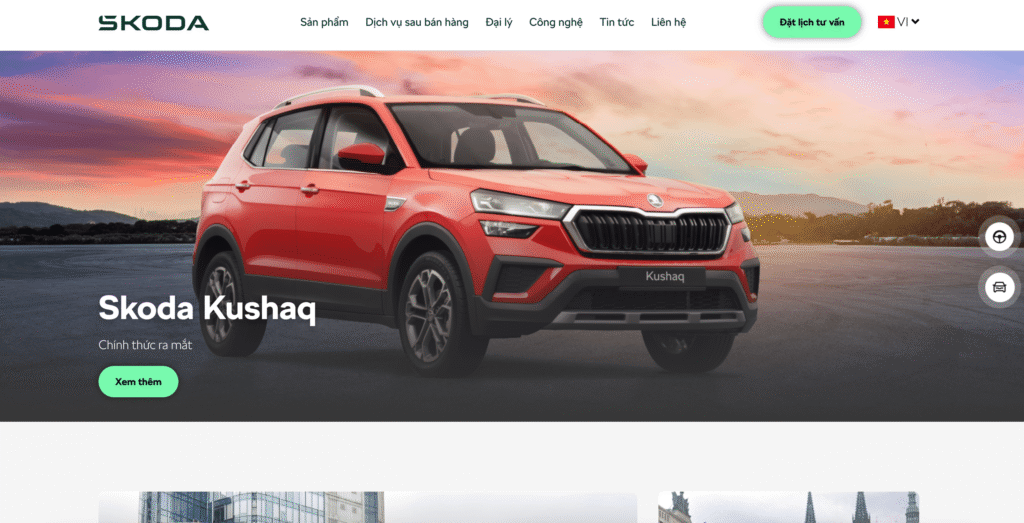
Skoda, the Czech automotive marque under the Volkswagen Group umbrella, has rapidly positioned itself as a rising contender in Vietnam’s automotive landscape. With a strategic blend of local assembly initiatives and a robust global EV roadmap, the brand is poised to become a notable player in Vietnam’s electric vehicle (EV) transformation by 2025.
1. Strategic Market Entry and Localization Roadmap
Early Presence and Assembly Tactics
- Skoda officially entered the Vietnamese market in 2023 through a strategic alliance with Thanh Cong Group.
- Leveraged its India-based CKD (Completely Knocked Down) supply chain for cost-effective model assembly in Vietnam.
- Focused on minimizing import duties and enhancing price competitiveness, aligning with Vietnam’s localization incentives.
Global Momentum Backing Local Entry
- Delivered 509,400 units globally in H1 2025 — a 13.6% YoY growth.
- Ranked as Europe’s third-best-selling automotive brand as of mid-2025.
- This international momentum strengthens the brand’s credibility and provides operational leverage for expansion into Southeast Asian markets like Vietnam.
2. Electric Vehicle (EV) Model Portfolio and Market Fit
Current Focus and Potential for EV Localization
- Initial models introduced in Vietnam include:
- ICE-based: Skoda Kushaq (locally assembled in H1 2025), and imported Karoq & Kodiaq SUVs.
- Skoda’s EV potential lies in its European portfolio, featuring the:
- Skoda Enyaq iV
- Skoda Elroq
- Over 120,000 global orders for the Enyaq and Elroq by June 2025 underline strong global demand.
Example: Skoda Enyaq 50 Specifications
| Feature | Specification |
|---|---|
| Usable Battery Capacity | 52.0 kWh |
| Real-world Range | ~310 km |
| AC Charging | 11 kW |
| DC Fast Charging | Up to 145 kW |
| Acceleration (0–100 km/h) | Approx. 8.7 seconds |
- These specifications cater well to urban Vietnamese consumers, especially those in growing eco-conscious cities like Hanoi and Ho Chi Minh City.
- While no formal announcement has been made about local EV assembly, the current CKD framework offers a scalable pathway for eventual domestic EV production.
3. Service Ecosystem and After-Sales Capabilities
Partnership-Driven Infrastructure
- Skoda’s service infrastructure is being built in partnership with Thanh Cong Group, a major Vietnamese automotive partner.
- Plans to integrate global service protocols with local dealership networks to ensure consistency and reliability.
Global Best Practices for Local Adaptation
- Skoda’s international service model includes:
- Biennial maintenance checks for electric models like the Enyaq (not mileage-based).
- Seasonal inspection programs and MOT preparation services.
- EV-specific diagnostics: Battery health assessments, software updates, and electrical system servicing.
Service Model Potential in Vietnam
- These service standards are expected to be introduced in Vietnam as Skoda rolls out more EV offerings.
- The presence of dedicated EV service infrastructure will play a critical role in building long-term brand trust and ensuring customer satisfaction.
4. Market Outlook: Why Skoda Ranks Among Vietnam’s Top 10 EV Brands in 2025
| Evaluation Criteria | Skoda’s Performance |
|---|---|
| Market Entry Strategy | Strategic CKD import + local assembly with Indian-Vietnam synergy |
| EV Product Roadmap | Strong global EV pipeline (Enyaq, Elroq); growing regional relevance |
| Sales Performance (Global) | Over 509,000 units sold in H1 2025 |
| Service Capabilities | Partnership-driven support with Thanh Cong Group |
| EV Readiness in Vietnam | High — poised for expansion from ICE to EV assembly locally |
| Affordability & Accessibility | Expected to offer more affordable EVs via localization strategy |
| Brand Recognition | Strengthened by VW Group backing and rapid global ascent |
- Skoda’s ability to blend affordability, European engineering quality, and scalable production gives it a unique position in Vietnam’s evolving EV market.
- As demand for clean mobility accelerates, Skoda’s early groundwork in localization and infrastructure is anticipated to pay long-term dividends.
Conclusion: Skoda’s Strategic Ascent in Vietnam’s EV Landscape
With its calculated entry into the Vietnamese market, strategic alliances for local assembly, and a robust global EV development pipeline, Skoda has laid the foundation to emerge as a serious EV contender. By offering models tailored to local preferences and gradually aligning with Vietnam’s electrification goals, Skoda rightfully earns its place among the Top 10 Electric Vehicle Brands in Vietnam in 2025.
Conclusion
As Vietnam positions itself at the forefront of Southeast Asia’s green mobility revolution, the competitive landscape of the electric vehicle (EV) market in 2025 reflects a dynamic convergence of innovation, consumer demand, and policy transformation. The emergence of top-tier EV brands—both domestic and international—has catalyzed a new era of mobility defined by sustainability, digital integration, and localized manufacturing.
VinFast Leads as a Homegrown Powerhouse
Dominating the domestic scene, VinFast continues to leverage its early-mover advantage, vertically integrated production model, and expansive national charging infrastructure. Its tailored offerings, including the VF 3 and VF 5, resonate with the practical needs and price sensitivities of Vietnamese consumers, especially in urban and peri-urban areas. The company’s strategic vision, anchored by its proprietary charging network (V-Green) and commitment to affordability, solidifies its role as a key architect of Vietnam’s EV ecosystem.
Chinese Brands Accelerate Market Penetration
Challengers such as BYD, MG, and Wuling are swiftly gaining ground by introducing competitively priced, feature-rich EV models that appeal to budget-conscious buyers and first-time adopters. Their growing local partnerships and plans for CKD (Completely Knocked Down) or SKD (Semi-Knocked Down) assembly indicate long-term investment in the Vietnamese market. With offerings like the BYD Dolphin and MG ZS EV, these brands are reshaping the entry and mid-tier segments with a compelling mix of technology and affordability.
Global Automakers Reinforce Their Premium Presence
Well-established international manufacturers such as Hyundai, Kia, Mercedes-Benz, BMW, and Skoda are reinforcing their presence, particularly in the premium EV market. Models like the Hyundai IONIQ 5, Skoda Enyaq, and Mercedes EQE represent a strategic shift toward electrified luxury and performance, targeting affluent urban consumers. These brands are also embracing localization strategies by setting up assembly facilities or forming joint ventures with Vietnamese firms to ensure cost competitiveness and regulatory alignment.
Key Trends Shaping Brand Success in Vietnam’s EV Market
- Localization of Manufacturing: Several brands are reducing costs and improving responsiveness by localizing assembly operations. This trend is essential for achieving scale and qualifying for government incentives.
- Charging Infrastructure Development: Brands with proprietary or well-partnered access to charging networks are gaining a strategic edge, particularly outside of urban centers.
- Government Support and Policy Frameworks: Vietnam’s proactive EV policies—including registration tax exemptions, reduced import duties, and roadmap alignment for net-zero goals—are accelerating market entry and adoption.
- Consumer Evolution: A new generation of eco-conscious, tech-savvy Vietnamese consumers is driving demand for smart, connected EVs with high safety standards and affordable operating costs.
What Differentiates the Top EV Brands in 2025?
- Product Affordability and Variety: Brands that offer a range of vehicles—from compact city cars to luxury SUVs—are better positioned to capture multiple market segments.
- After-Sales Service and Warranty Policies: Competitive warranty coverage, battery replacement programs, and robust service networks are becoming critical differentiators.
- Digital Integration: Advanced infotainment systems, mobile app connectivity, and over-the-air (OTA) updates are increasingly influencing purchase decisions.
- Sustainability Branding: Consumers are beginning to value brands not only for product quality but also for environmental commitment and ESG (Environmental, Social, and Governance) credentials.
Final Thoughts: The Future of Vietnam’s EV Brand Ecosystem
Vietnam’s top 10 electric vehicle brands in 2025 exemplify the vibrancy and competitiveness of a market in transition. While VinFast currently leads with unmatched market penetration and ecosystem control, foreign brands are quickly adapting, localizing, and innovating to gain share. The result is a diverse and rapidly maturing EV landscape that offers Vietnamese consumers more choices, better technology, and stronger service standards than ever before.
Looking forward, success in Vietnam’s EV market will be determined not only by vehicle performance and pricing but also by long-term strategic investments in infrastructure, partnerships, and policy alignment. The brands that anticipate regulatory changes, embrace digital transformation, and invest in community-level charging solutions will be best positioned to lead the market through 2030 and beyond.
Ultimately, the top EV brands of 2025 are not just selling cars—they are shaping Vietnam’s path toward a cleaner, smarter, and more sustainable transportation future.
People Also Ask
What are the top electric vehicle brands in Vietnam in 2025?
The top EV brands in Vietnam in 2025 include VinFast, BYD, Hyundai, MG, Kia, Mercedes-Benz, BMW, Skoda, Porsche, and Wuling.
Which electric car brand is the most popular in Vietnam in 2025?
VinFast is the most popular EV brand in Vietnam in 2025, thanks to its affordable models and nationwide charging network.
Is BYD a major player in Vietnam’s EV market in 2025?
Yes, BYD has gained significant traction in Vietnam with competitively priced models and plans for local assembly.
How is MG performing in Vietnam’s EV segment in 2025?
MG is expanding rapidly, offering budget-friendly electric cars with good range and building a strong local presence.
Are luxury EVs popular in Vietnam in 2025?
Yes, brands like Mercedes-Benz, BMW, and Porsche have growing demand among high-income consumers seeking premium EV experiences.
Which EV model is the best-selling in Vietnam in 2025?
VinFast’s VF 3 and VF 5 models are among the best-selling EVs due to their affordability and suitability for urban driving.
Is Hyundai assembling electric vehicles locally in Vietnam?
Yes, Hyundai has begun local assembly of the IONIQ 5, improving pricing and availability for Vietnamese consumers.
What are the advantages of VinFast EVs in 2025?
VinFast EVs offer competitive pricing, government support, strong after-sales service, and a vast charging network.
How many electric vehicle brands are competing in Vietnam in 2025?
Over 15 brands are actively competing, but the top 10 dominate the market share through price, technology, and availability.
Are electric vehicles affordable in Vietnam in 2025?
Affordability is improving, especially for entry-level models from VinFast, MG, and BYD, supported by government incentives.
Does Vietnam have enough EV charging stations in 2025?
Charging infrastructure is expanding, led by VinFast and other providers, but development is still uneven outside major cities.
Is there government support for EV buyers in Vietnam?
Yes, buyers benefit from reduced registration fees, lower taxes, and incentives aimed at promoting EV adoption nationwide.
How does Kia rank in Vietnam’s EV market in 2025?
Kia is gaining ground with models like the EV6, appealing to mid-range consumers looking for performance and design.
Which Chinese EV brands are in Vietnam in 2025?
Chinese brands like BYD, MG, and Wuling are present, offering affordable EV options and exploring local partnerships.
What is the future outlook for EV adoption in Vietnam?
Vietnam’s EV market is expected to grow steadily, driven by policy support, green awareness, and improving infrastructure.
Are there any local Vietnamese EV startups apart from VinFast?
As of 2025, VinFast remains the dominant local EV brand, with no major domestic competitors reaching comparable scale.
What role does BMW play in Vietnam’s EV segment?
BMW targets the premium segment with models like the iX and i4, focusing on innovation, performance, and luxury.
Is Skoda selling EVs in Vietnam in 2025?
Yes, Skoda has launched EVs like the Enyaq and is assembling vehicles locally to strengthen market access.
Are Vietnamese consumers open to EV adoption?
Yes, consumer awareness and demand are rising, especially in urban areas, driven by cost savings and sustainability goals.
What is the price range for EVs in Vietnam in 2025?
EVs in Vietnam range from under $10,000 for mini EVs to over $100,000 for luxury models, catering to all budget segments.
Are EVs cheaper to maintain than petrol cars in Vietnam?
Yes, EVs generally have lower maintenance costs due to fewer moving parts and no need for oil changes or fuel.
How do Porsche EVs perform in Vietnam’s market?
Porsche’s EVs, especially the Taycan, cater to affluent buyers and benefit from exclusive high-power charging infrastructure.
Do foreign brands plan to expand EV manufacturing in Vietnam?
Yes, several global brands are exploring local assembly and partnerships to lower costs and tap into domestic demand.
What factors influence EV brand popularity in Vietnam?
Key factors include price, range, charging availability, after-sales service, brand reputation, and government incentives.
Which EV brand has the most charging stations in Vietnam?
VinFast leads with the most extensive charging network, covering all 63 provinces with thousands of ports.
Are Vietnamese EVs exported to other countries?
Yes, VinFast has begun exporting EVs to the U.S., Europe, and other markets as part of its global expansion strategy.
How is the Vietnamese government supporting EV infrastructure?
The government is encouraging investment through incentives and regulatory frameworks to expand nationwide charging coverage.
What challenges do EV brands face in Vietnam?
Challenges include limited charging infrastructure, high import costs, consumer hesitation, and competition from ICE vehicles.
Are EVs a viable option for long-distance travel in Vietnam?
Yes, with ongoing development of charging networks, EVs are becoming more practical for long-distance routes.
How can consumers choose the best EV brand in Vietnam?
Consumers should compare range, price, warranty, charging compatibility, and brand reliability before making a decision.
Sources
Tilleke & Gibbins
Vietnam Law and Legal Forum
Mint
SIA
MarkLines
Vietnam News
VinFast
TechNode Global
AInvest
Vietnam Investment Review (VIR)
VietnamPlus
Market Report Analytics
Charge+
THACO Group
Mercedes-Benz USA
MG Cars
V-Green
Kia Motors
InsideEVs
Top Gear
Edmunds
Zigwheels
EVXL
BMW i Forums (Bimmerpost)
IMARC Group
B&Company
The Investor
Investing.com
Škoda Auto
Porsche
BMW Vietnam
AckoDrive
Licarco
ZeCar
Wikipedia
EV Database
BMW Blog
Porsche Newsroom
Mercedes-Benz Vietnam
Hyundai USA
ABB
TQ Wuling Vietnam
CarFigures
Kia News Center
BYD
Green in Vietnam
SGGP News
HD Hyundai Electric
MG Trường Chinh
Thanh Niên
OKXE
VinFast Global Community
Volkswagen Group
